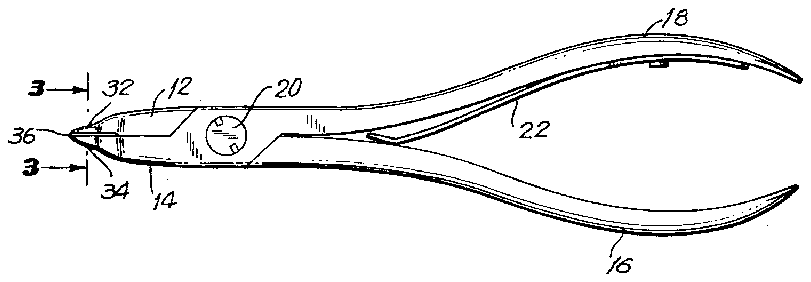

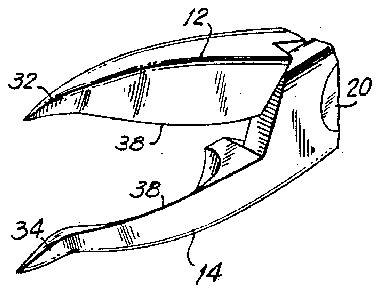
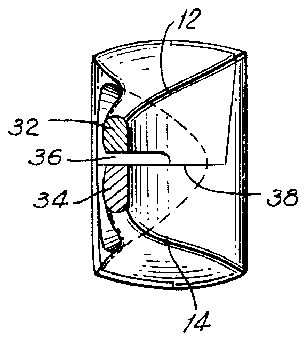
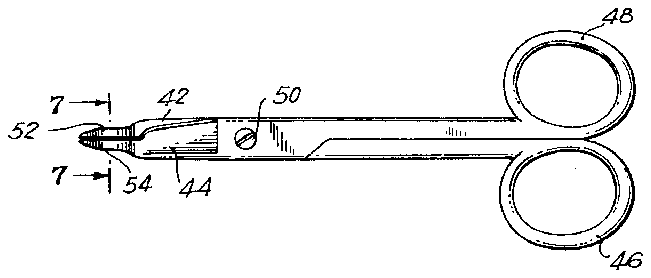

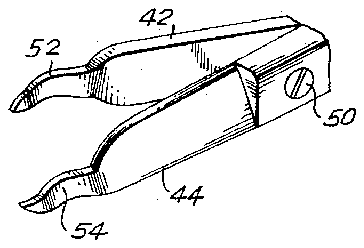
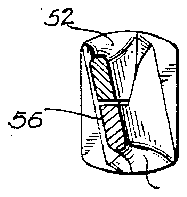
- 21967 sheet
- 3perles
- 4march
- 12blades
- 14blades
- 15 references cited
- 16handles
- 17a61b
- 18handles
- 20pivot means
- 22conventional leaf spring
- 29a45d
- 32guard portions
- 33line
- 34portions
- 38cutting edges
- 42lower blades
- 44lower blades
- 46handles
- 48handles
- 50pivot
- 52guard portions
- 54guard portions
- 56gap
- 64end portions
- 340perles
- 430perles
Description
March 4, 1969 D. R. PERLES 3,430,340
SAFETY CUTTING INSTRUMENT FOR PEDICURE Filed June 21, 1967 sheet 2 INVENTOR. DAVID R. PERLES ATTORNEYS March 4, 1969 D. R. PERLES 3,430,340
SAFETY CUTTING INSTRUMENT FOR PEDICURE Filed June 21, 1967 Sheet 2 or 2 INVENTOR. DAVID R. PERLES ATTORNEYS United States Patent 3,430,340 SAFETY CUTTING INSTRUMENT FOR PEDICURE David R. Perles, 399 Delavan Ave., Byram, Conn. 10573 Filed June 21, 1967, Ser. No. 647,837 US. C]. 3023 Int. Cl. A45d 29/02, 29/18; A61b 17/32 3 Claims ABSTRACT OF THE DISCLOSURE BACKGROUND OF THE INVENTION Many people suffer from ingrown toenails. The most common cause is a tendency to trim around the sides of the nail, instead of simply across the end of the nail.
SUMMARY OF THE INVENTION The present cutting instrument comprises upper and lower blades with handles and a pivot means, the blades being very short relative to the handles, and the end portions of the blades acting as guard portions. The guard portions are dull or flattened, and they are cut away so that they do not meet with a cutting action even when the blades are operated by means of the handles. The short cutting portions of the blades are located between the guard portions and the pivot means. Also when viewed in plan, with the instrument in usual upright position, the guard portions are offset from the cutting portions of the blades. The guard portions thus provide safety in three ways, for they have no cutting edge; they do not even meet; and they are olfset rearward or away from the nail being cut. These safety features are applicable to either clippers or scissors.
The foregoing and additional features are described in the following detailed specification, which is accompanied by drawings in which:
FIG. 1 is an elevation showing clippers embodying features of the present invention;
FIG. 2 is a plan view;
FIG. 3 is a section drawn to enlarged scale and taken approximately on the line 33 of FIG. 1;
FIG. 4 is a fragmentary perspective view with the clipper blades open;
FIG. 5 is an elevation showing scissors embodying the present invention;
FIG. 6 is a plan view of the same;
FIG. 7 is a transverse section drawn to larger scale, and taken approximately on the line 7-7 of FIG. 5; and
FIG. 8 is a fragmentary perspective view showing the blades in open position.
Referring to the drawing, and more particularly to FIGS. 1 through 4, the safety clippers for pedicure comprise upper and lower blades 12 and 14 with handles 16 and 18 respectively, and a pivot means 20 which pivots the blades for cutting action by means of the handles. The pivot may be conventional, and in FIG. 2 is merely suggested in dotted lines, rather than shown in detail. The instrument includes resilient means tending to open the same, and in the present case a conventional leaf spring 22 (FIG. 1) is used for that purpose. The clippers are normally open, although shown in closed position in FIGS. 1, 2 and 3.
The blades 12 and 14 are very short, relative to the length of the handles 16 and 18. The end portions 32 and 34 of the blades 12 and 14 act as guard portions which are dull, and indeed, are preferably flattened to substantial width, as is most clearly shown in FIG. 3. Moreover, they preferably are cut away so that they do not even meet. The resulting clearance therebetween is most clearly shown at 36 in FIG. 3.
The guard portions are preferably offset from the cutting portions of the blades, when viewed from above, as shown in FIG. 2. The cutting edges come into edge to edge relation, and are shown in dotted lines at 38 in FIG. 2, and it will be seen that the guard portions 32 are offset rearwardly from the cutting edges 38 by a Substantial distance. FIG. 4 also shows the sharp cutting edges 38 of the blades 12 and 14, and the flattened offset guard portions 32 and 34.
On reflection it will be seen that this construction makes it diflicult to trim the side edges of a toenail, Without however interfering with easy trimming across the end of the toenail. The instrument therefore discourages the side trimming which usually leads to an ingrown toenail condition.
Referring now to FIGS. 5 through 8 of the drawing, the features of the present improvement are shown applied to a pedicure instrument of the scissors type. Here again there are upper and lower blades 42 and 44, with handles 46 and 48 respectively, and a pivot 50. The pivot may be conventional, and is merely suggested in FIG. 6. The blades are very short relative to the length of the handles, and the end portions 52 and 64 of the blades act as guard portions, which are dull or even flattened, and which are cut away so that they do not meet with a cutting action even when the blades are operated by the handles. The flattening of the guard portions 52 and 54, as well as the gap 56 therebetween, are most clearly shown in FIG. 7.
Here again the instrument when viewed in plan, and when in its usually upright position as shown in FIG. 6, has guard portions which are offset from the cutting portions of the blades, these ofiset portions preferably being rearward or away from the toenail which is being trimmed.
In scissors, the cutting portions of the blades slide past one another with a shearing action, as will be seen from a comparison of FIGS. 5 and 8. However, the guard portions 52 and 54 do not slide past one another, and instead are cut away for a substantial distance, and may be so shaped that the flattened edges are superposed rather than side by side, as will be seen in FIG. 7.
This construction prevents, or at least greatly discourages, trimming of the side edges of a toenail, and instead, the tendency is to simply cut the nail across the end, as should be done.
It is believed that the construction and method of use of my improved safety cutting instruments for pedicure, as well as the advantages thereof, will be apparent from the foregoing detailed description. It will also be understood that while I have shown and described the improvement in several preferred forms, changes may be made without departing from the scope of the invention, as sought to be defined in the following claims.
I claim:
1. A safety cutting instrument for pedicure comprising, upper and lower blades having handles, each blade having a sharp cutting portion, pivot means pivoting the blades for cutting action by means of the handles, the cutting portions of said blades being very short relative to the length of the handles, said blades having dull end portions, said end portions being opposed and spaced apart so that they do not meet even when said blades are in a normally closed position, the short cutting portions of the blades being located between the end portions and the pivot means, the entire end portions being ofiset laterally from the short cutting portions of the blade, thereby providing guards for discouraging trimming around the sides of a toenail to prevent ingrown toenails.
2. A safety cutting instrument as defined in claim 1, in which the blades are clipper blades the cutting portions of which come into edge to edge relation, and in which the instrument is provided with resilient means tendng to separate the handles and blades.
3. A safety cutting instrument as defined in claim 1, in which the blades are scissors blades the cutting portions of which slide past one another with a shearing action, and the end portions of which do not slide past one another.
References Cited 15 ANDREW R. JUHASZ, Primary Examiner. G. WEIDENFELD, Assistant Examiner.
US. Cl. X.R.







